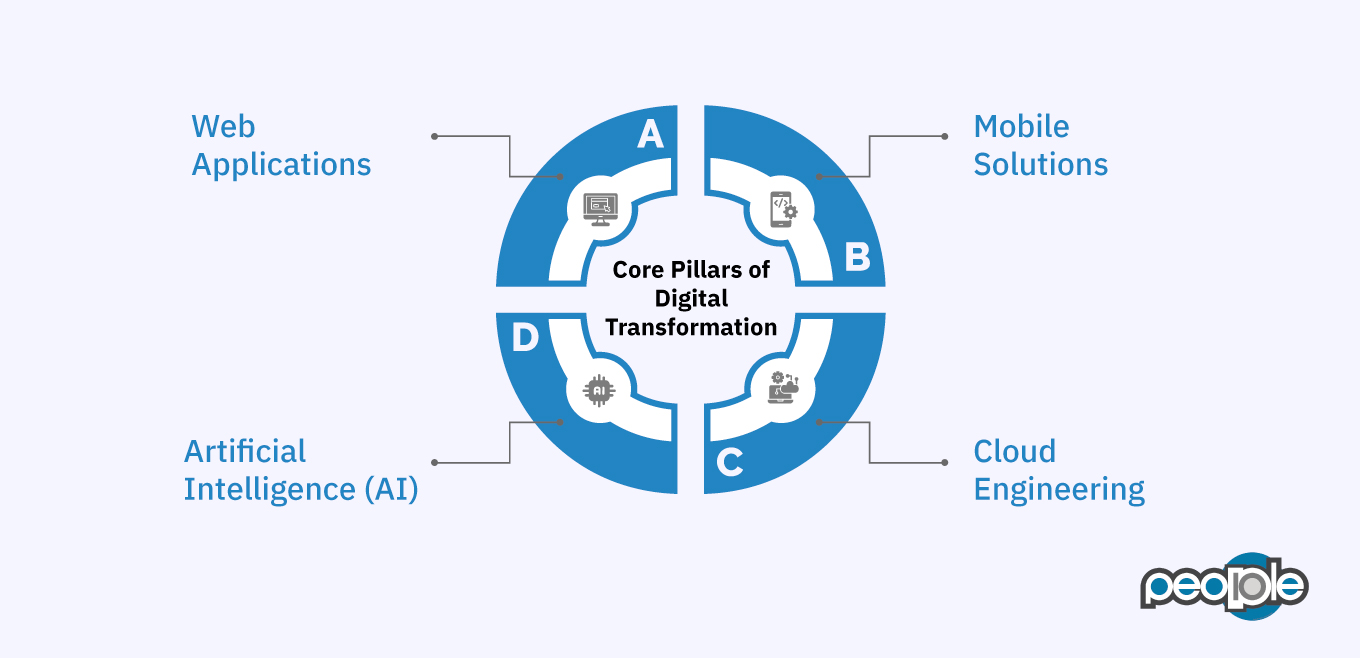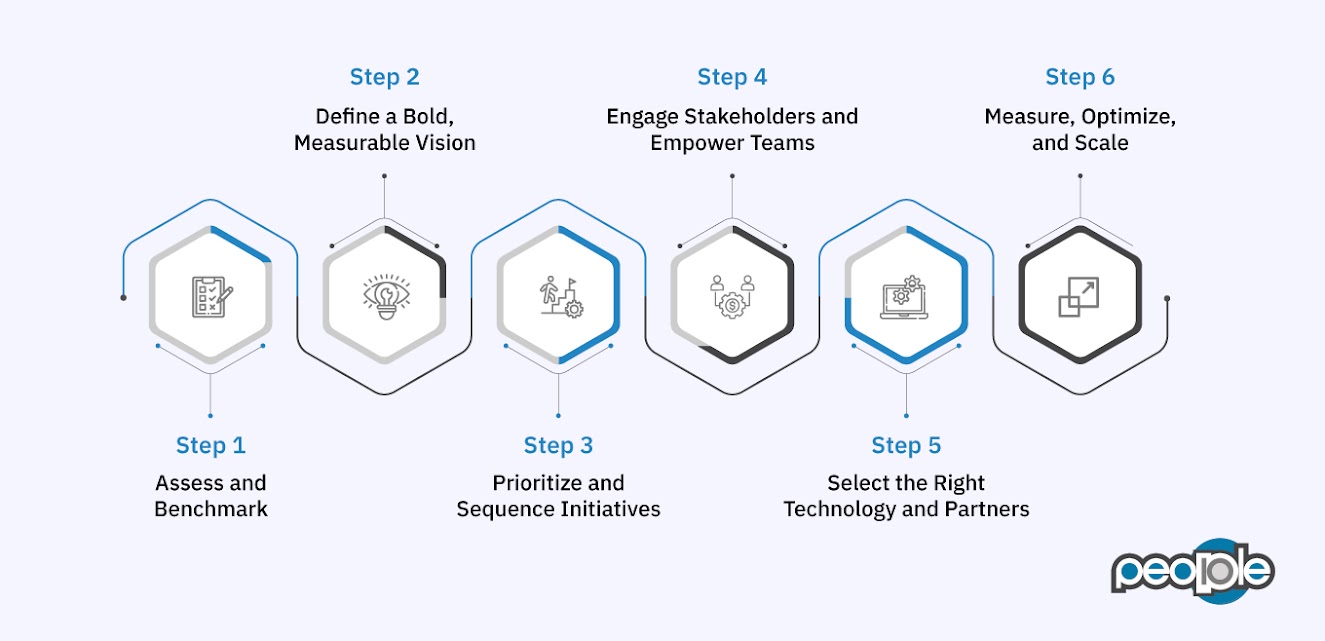Digital transformation has become a cornerstone of enterprise survival and growth. As technology and customer expectations evolve quickly, enterprises must continually rethink how they deliver value, drive efficiency, and outpace competitors. Yet, the path to successful transformation is riddled with opportunities and challenges.
From adopting enterprise web application development to leveraging cloud engineering and artificial intelligence (AI), digital transformation is not a one-time project—it’s a fundamental, continuous shift in how businesses operate and innovate. This guide explores what true digital transformation means for enterprises, the technologies driving this evolution, the common hurdles, and actionable steps for lasting success.
What is Digital Transformation?
Over 80% of business executives view digital transformation initiatives as non-negotiable for their organization’s success.
Digital transformation is more than a trend or a buzzword; it’s a fundamental evolution in how enterprises operate, compete, and serve their customers. It is about leveraging technology to drive efficiency, innovation, and new value creation across all business areas. For enterprises, this means reimagining business models, streamlining operations, and enhancing customer experiences by integrating advanced digital tools and mindsets.
Gone are the days when digital transformation was only about moving legacy processes online or adopting a handful of cloud-based applications. Today’s digital transformation encompasses everything from enterprise web application development and cloud engineering to artificial intelligence (AI) and advanced analytics. It requires enterprises to break down traditional silos, rethink organizational structures, and foster a culture that welcomes change, experimentation, and ongoing learning.
Why is Digital Transformation Critical, Especially Now?
The answer lies in rapidly evolving customer expectations, the relentless pace of technological innovation, and the growing need for agility. Customers and partners now expect seamless digital journeys, personalized interactions, and real-time responsiveness. Meanwhile, digital-native competitors are rewriting the rules, forcing established enterprises to accelerate their transformation or risk being left behind.
True digital transformation isn’t a one-time project. It’s an ongoing journey that fundamentally changes an enterprise’s DNA. It starts with a bold vision, but success depends on strategy, leadership commitment, and a willingness to embrace uncertainty.
Core Pillars of Digital Transformation

The four key pillars power digital transformation include:
- Web applications
- Mobile solutions
- Cloud engineering
- Artificial intelligence (AI)
These pillars work together to help enterprises become faster, smarter, and more scalable. Let’s look at them one after the other.
Enterprise Web Application Development
Web applications form the digital backbone of modern enterprises. Robust, scalable, and user-friendly enterprise web applications streamline workflows, connect global teams, and unlock new digital business models.
Modern web applications go far beyond traditional portals or static intranets. They are modular, API-driven, and designed with security and compliance in mind. By modernizing legacy systems into agile, cloud-native web applications, enterprises can deliver faster feature rollouts, integrate with partners, and create more engaging user experiences.
Successful enterprise web application development hinges on a few key practices:
- User-Centric Design: Apps should be intuitive and accessible, driving adoption across diverse user groups.
- Agile Delivery: Frequent releases and feedback loops ensure applications evolve in sync with business needs.
- API Ecosystems: Open APIs and microservices architectures allow enterprises to integrate seamlessly with third-party tools, platforms, and data sources.
- Security by Design: In a landscape of growing cyber threats, security must be built in from the ground up.
Mobile App Development for the Enterprise
With the rise of remote work, field operations, and customer mobility, mobile apps are now central to the digital enterprise strategy. Partnering with the right mobile app development company can unlock new ways to connect with employees, customers, and business partners anywhere.
Key factors for successful mobile transformation:
- Cross-Platform Solutions: Develop once, deploy everywhere—on iOS, Android, and wearable devices.
- Integration with Core Systems: Mobile apps should interface smoothly with CRM, ERP, and supply chain systems.
- Real-Time Data: Push notifications, offline capabilities, and instant messaging power critical business workflows and customer engagement.
- Enterprise Security: Mobile device management (MDM), secure authentication, and compliance controls are essential.
A logistics company, for example, can digitize dispatch, proof of delivery, and real-time tracking, dramatically reducing operational delays and errors.
Cloud Engineering: The Agile Backbone
Cloud engineering is a game-changer for enterprises seeking flexibility and rapid scaling.
By moving infrastructure, platforms, and services to the cloud, enterprises can reduce IT overhead, accelerate innovation, and respond faster to new business opportunities. Cloud-native architectures empower organizations to:
- Scale up or down on demand, ensuring cost efficiency
- Support remote and distributed teams globally
- Leverage Infrastructure as Code for consistency and automation
- Integrate seamlessly with AI, analytics, and IoT services
Leading enterprises often embrace hybrid or multi-cloud strategies to avoid vendor lock-in, enhance resilience, and optimize workloads for performance and cost.
Case Study: AI-Driven Cloud Modernization in Healthcare
A leading healthcare technology provider approached People10 to modernize a complex legacy application critical to care coordination across clinics. The system struggled with poor user experience, rigid architecture, and rising maintenance costs.
People10 Technologies executed a full-stack transformation:
- Re-architected the platform into a microservices-based, cloud-native application on AWS
- Integrated AI-driven clinical intelligence features for care personalization
- Enabled real-time data synchronization with third-party hospital systems
- Migrated from on-prem infrastructure to a secure, compliant cloud environment
The Results:
- 40% better system responsiveness
- 70% lower support overhead
- Faster go-to-market for new features
- Improved patient engagement with personalized dashboards
This transformation showcases how combining cloud engineering with AI cuts costs and enables enterprise-grade scalability and innovation.
Artificial Intelligence: The Next Frontier
AI is transforming every aspect of enterprise operations—from process automation and predictive analytics to personalized customer experiences.
Key applications of artificial intelligence in the enterprise include:
- Predictive Maintenance: AI-driven analytics can forecast equipment failures before they disrupt operations.
- Smart Automation: Robotic process automation (RPA) and intelligent bots streamline repetitive tasks, freeing human talent for higher-value work.
- Customer Personalization: AI engines analyze data at scale to deliver individualized recommendations, offers, and support.
- Decision Support: Advanced machine learning models help leaders make faster, data-driven decisions.
In healthcare, AI enables faster diagnoses and personalized care pathways. In retail, it drives smarter merchandising, demand forecasting, and customer engagement.
Navigating the Challenges of Enterprise Digital Transformation
While digital transformation offers immense strategic value, its execution is rarely linear. Enterprises face a range of challenges—from technical complexity and organizational inertia to talent gaps and integration risks. Based on People10 Technologies’ experience leading complex digital transformation, the most common obstacles and proven strategies to overcome them are as follows:
Legacy Systems and Technical Debt
Many enterprises still rely on outdated systems built for a pre-digital era. These monolithic platforms hinder agility, limit integration, and drain IT budgets. Migrating to modern, cloud-native architectures is essential but requires careful planning and phased execution.
Tip: Use APIs and microservices to decouple legacy systems, allowing gradual modernization without disrupting business continuity.
Cultural Resistance and Change Management
Transformation is as much about people as it is about technology. Employees may fear change, new workflows, or job automation. Building a culture that values learning, experimentation, and collaboration is crucial.
Tip: Engage stakeholders early, provide ongoing training, and celebrate quick wins to build momentum and buy-in.
Data Silos and Integration Hurdles
Disparate systems often result in fragmented data, making it hard to achieve a unified view of customers and operations. Integration platforms and a robust data strategy are essential to break down silos and enable data-driven decision-making.
Security, Compliance, and Governance
Rapid innovation should never come at the expense of security and compliance. Enterprises must embed security into every layer of the digital stack, from mobile apps to cloud services.
Tip: Adopt “security by design” principles, conduct regular audits, and stay current with regulatory requirements (GDPR, HIPAA, etc.).
Skill Gaps and Resource Constraints
The demand for expertise in cloud engineering, AI, and enterprise app development often outpaces available talent. Strategic partnerships with leading service providers like People10 Technologies, continuous upskilling, and leveraging managed services can fill the gaps.
Building a Roadmap for Digital Transformation Success


A successful digital transformation journey starts with a clear, actionable roadmap.
Step 1: Assess and Benchmark
Evaluate current systems, workflows, digital maturity, and organizational culture. Identify pain points, bottlenecks, and untapped opportunities.
Benchmark against industry leaders to set realistic, inspiring goals.
Step 2: Define a Bold, Measurable Vision
Articulate what digital success looks like. Align technology initiatives with business objectives, such as operational efficiency, new revenue streams, or enhanced customer experience.
Set KPIs that track progress: adoption rates, process efficiency, customer satisfaction, and financial impact.
Step 3: Prioritize and Sequence Initiatives
Not all transformation projects can (or should) start at once.
Prioritize quick wins that demonstrate value early, while planning for long-term, structural changes (such as full-scale cloud migration or AI-driven product innovation).
Step 4: Engage Stakeholders and Empower Teams
Digital transformation is cross-functional. Involve IT, operations, HR, customer service, and executive leadership.
Build empowered, agile teams that can experiment, iterate, and respond quickly to feedback.
Step 5: Select the Right Technology and Partners
Enterprises that partner with firms like People10 accelerate outcomes with less risk and better continuity. People10 Technologies is experienced in enterprise web application development, modernization, cloud-native engineering, and AI delivery. We focus on open, scalable, and secure architectures that evolve with your business needs.
Step 6: Measure, Optimize, and Scale
Adopt a continuous improvement mindset. Regularly measure progress, solicit feedback, and optimize strategies based on data.
Scale successful pilots into enterprise-wide solutions.
Measuring and Sustaining the Impact of Digital Transformation
Transformation isn’t a sprint—it’s a marathon that requires relentless focus and agility.
- Customer Experience: Improvements in Net Promoter Score (NPS), retention, and digital engagement rates
- Operational Efficiency: Reductions in process times, manual errors, and costs
- Revenue Growth: Increases from new digital products, channels, and customer segments
- Employee Engagement: Adoption of new tools, satisfaction with digital workflows, and collaboration metrics
- Risk Reduction: Fewer incidents, faster recovery, and enhanced compliance
Conclusion: The Future Belongs to the Digitally Mature Enterprise
Digital transformation is no longer optional. It’s the key to staying competitive, resilient, and ready for the future. Enterprises that modernize their systems, embrace the cloud, and use AI effectively can move faster, serve customers better, and grow smarter. But success doesn’t come from technology alone. It comes from choosing the right strategy, building the right solutions, and working with the right partner.
At People10, we help enterprises turn transformation plans into working systems. Our teams combine deep engineering expertise with real-world delivery experience. Whether you are modernizing legacy platforms, launching new digital services, or scaling with AI, we are here to help you make it real.
Ready to accelerate your digital journey?
Partner with People10 and build the foundation for long-term success.
Author
Shrutha Sekharaiah brings over 13 years of experience in delivering innovative, scalable solutions. His broad expertise in technology and focus on collaboration and mentorship drive the creation of robust systems enhancing efficiency and performance.




